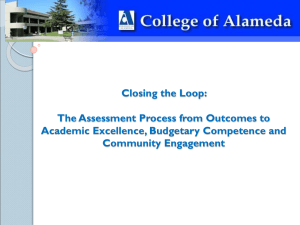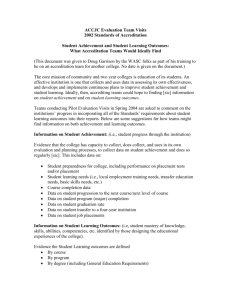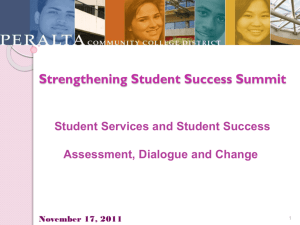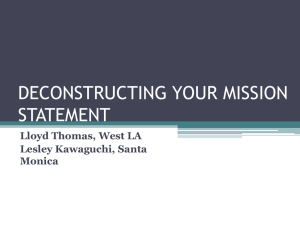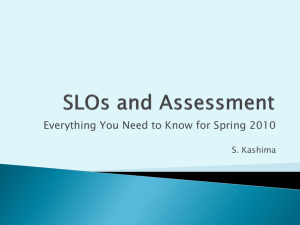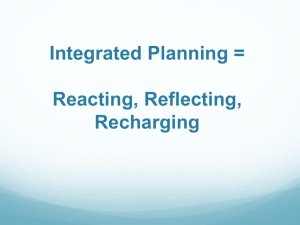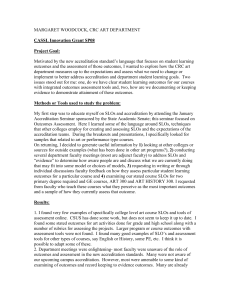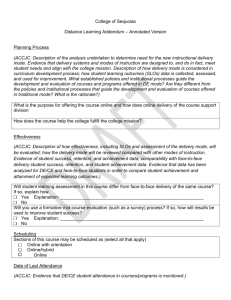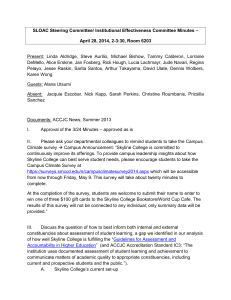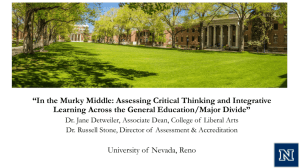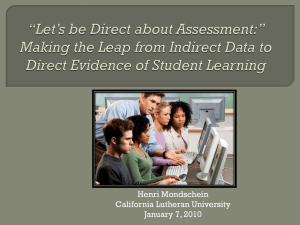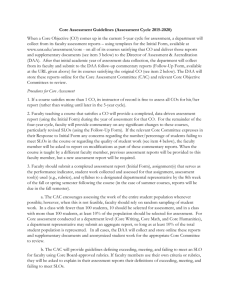Professional Development Activity on Assessment
advertisement
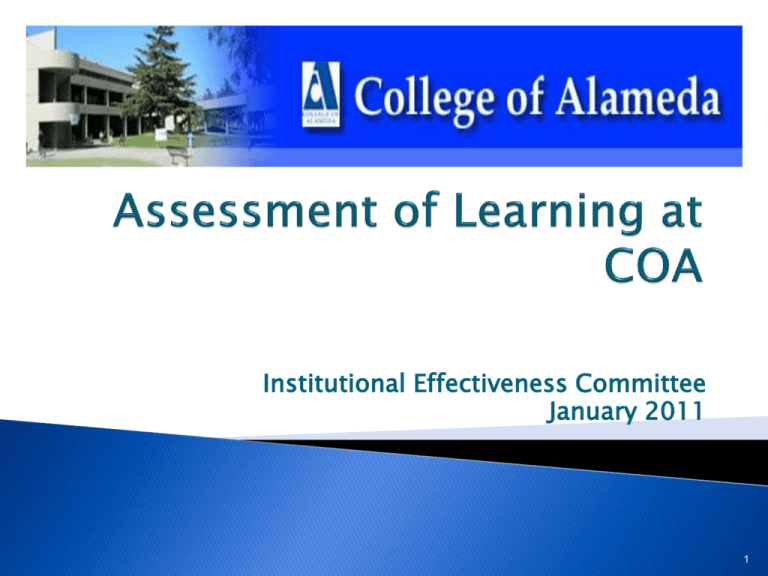
Institutional Effectiveness Committee January 2011 1 Review the ACCJC requirements on assessment Review the SLOs Identify assessment plans for all courses Develop an Assessment Calendar Establish deadlines and delegate responsibilities 2 Since 2007, the Accrediting Commission for Community and Junior Colleges (ACCJC) has clearly stated its expectation that colleges currently be at the "Continuous Sustainable Quality Improvement" level for Program Review and Planning on rubrics that ACCJC has provided. 3 Moreover, ACCJC has told colleges that they must be at the "Proficiency" level for student learning outcomes (SLOs) by end of Fall 2012. What does "Proficiency" look like on the ACCJC Rubric? 4 Student learning outcomes and authentic assessment are in place for courses, programs and degrees. Results of assessment are being used for improvement and further alignment of institution-wide practices. 5 There is widespread institutional dialogue about the results. Decision-making includes dialogue on the results of assessment and is purposefully directed toward improving student learning. Appropriate resources continue to be allocated and fine-tuned. 6 Comprehensive assessment reports exist and are completed on a regular basis. Course student learning outcomes are aligned with degree student learning outcomes. Students demonstrate awareness of goals and purposes of courses and programs in which they are enrolled. 7 In examining each of these characteristics, where would we place our college? Our respective disciplines? What would we need to do in order to achieve each of them? How do these characteristics interact with the rubrics for program review and planning and institutional outcomes? How can IEC help to achieve Proficiency? 8 Percent of Course with SLOs: 58% Percent of Programs with SLOs: 36 % Percent of Courses with Ongoing Assessment: 3% Percent of Programs with Ongoing Assessment: 29 % Percent of Student and Learning Services with SLOS: 53 % Percent of Student and Learning Services with Ongoing Assessment: 26% 9 “It involves systematically gathering, analyzing, and interpreting evidence to determine how well performance matches those expectations and standards; and using the resulting information to document, explain, and improve performance.” ◦ (Source: AAHE Bulletin, Thomas A. Angelo, 1995) 10 Assessment is the process of gathering and discussing information from multiple and diverse sources in order to develop a deep understanding of what students know, understand, and can do with their knowledge as a result of their educational experiences; the process culminates when assessment results are used to improve subsequent learning. (p. 8) Huba, M. E. & Freed, J. E. (2000). Learner-Centered Assessment on College Campuses - Shifting the Focus from Teaching to Learning. Boston: Allyn and Bacon. 11 Three types with different levels of focus: Institutional assessment Curricular and program assessment Course and learner-centered assessments Our focus for this session: Course and student learning support services. 12 We assess to ASSIST students in learning more. We asses to decide when students are ready to ADVANCE. And we assess to ADJUST our teaching and services to improve student learning. 13 What assessment evidence will be collected? When and how often will it be done? Who will assess and reflect on the results? How will results, implications, and related changes be documented? 14 James O. Nichols and Karen W. Nichols: A ROAD MAP FOR IMPROVEMENT OF STUDENT LEARNING AND SUPPORT SERVICES THROUGH ASSESSMENT 15 16 Learning outcomes or learning intentions What do we want students to know and be able to do as a result of this learning experience Achievement criteria or success criteria What will students need to do in (or out of) class to achieve the learning outcomes/learning intentions, and to what standard? Context or task What kind of learning experience will be appropriate to achieve the learning outcomes/learning intentions? 17 Direct measures Students demonstrate their learning by doing something, such as responding to a test question or writing an essay. Indirect measures Ask for perceptions or opinions about learning from students or other selfassessment or assessment by others. 18 Direct Methods Indirect Methods Standardized tests Certificate exams Locally developed tests/test questions Rubrics for evaluating: Essays/Papers Labwork Exam questions Capstone projects Exhibits Performances/Presentations Portfolios of student work Comprehensive exams Surveys Student Alumni Employer Exit interviews Focus groups Job placement rates Course evaluations 19 Focus on what you have been doing so well thus far. Be aware that the assessment instruments should be valid and reliable interesting and meaningful to faculty and staff. Include at least one direct method of assessment. 20 To improve reliability, use more than one assessment method per outcome. Okay to sample students and to sample students’ work. As needed, develop your own scoring rubrics for qualitative data student essays and reports, team projects, oral presentations 21 When and where will the assessment take place? Will you need to develop a scoring rubric?\ Will you use any sampling (of students, of student work)? How will you motivate your students to do their best work on this assessment? 22 What is your plan for sharing the results with faculty? When will results be shared, and with whom? Consider semester meetings Include time to reflect on the results. Keep track of recommendations for improvements and how they were implemented. Report the aggregated findings in TaskStream by the end of the semester. 23 The primary purpose of identifying and assessing learning outcomes at the program level is for program improvement. Assessment at the program level is based on aggregated student performance data; it is not intended to give feedback to individual students. Assessment is a faculty and classified professionalsowned and managed process. Purpose is to provide feedback to us about how well they are meeting their program goals; not an administrative tool for making decisions regarding program cuts. Documenting how we used assessment results to make program improvements is as important to ACCJC as the actual results of the assessment. 24 Angelo, T. (1995) Defining (and Re-assessing) Assessment: A Second Try, AAHE Bulletin no. 48, Angelo, T., and Cross, P. (1993). Classroom Assessment Techniques A Handbook for College Teachers. San Francisco: Jossey-Bass. Austin, at al. AAHE's 9 Principles of Good Practice for Assessing Student Learning http://www.apa.org/ed/governance/bea/assess.aspx#studen t-learning Assessing Student Learning in Community Colleges, Janet Fulks (an online workbook -click the link at the left to access it). The direct URL is: http://online.bakersfieldcollege.edu/courseassessment/ 25 Assessment Clear and Simple: A Practical Guide for Institutions, Departments, and General Education, Barbara E. Walvoord, Jossey-Bass, 2004. Assessing Student Learning: A Common Sense Guide, Linda Suskie, Anker, 2004. Assessing Academic Programs in Higher Education, Mary J. Allen, Anker, 2004. Bloom, B. S. (Ed.) Taxonomy of Educational Objectives: THe Classification of Educational Goals. Handbook I: Cognitive Doman. White Plains, NY: Longman, 1956. Gronlund, N. E. Measurement and Evaluation in Teaching. 4th ed. New York: Macmillan, 1981. 26 Effective Grading: A Tool for Learning and Assessment, Barbara E. Walvoord and Virginia Johnson Anderson, JosseyBass, 1998. Introduction to Rubrics: An Assessment Tool to Save Grading Time, Convey Effective Feedback, and Promote Student Learning, Danelle D. Stevens, Stylus, 2005. 27
